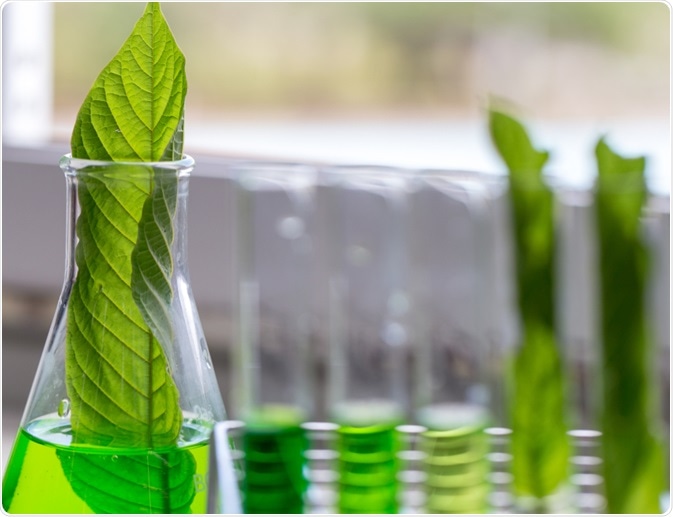
Image Credit: ©Rattiya Thongdumhyu/Shutterstock.com
Despite dwindling reservoirs of crude oil and coal, there is still an increasing demand for the petroleum-based chemicals and materials produced from these fossil fuels. Today, modern society is urgently trying to find alternative resources for fuels and chemical production.
First- and second-generation biofuels
First-generation biofuels are fuels generated using food crops such as grains and sugar beet, but these resources are limited in their ability to serve as a substitution for oil products and in meeting climate change targets.
This has led to the development of “second-generation” or advanced biofuels, fuels produced from feedstock that are not generally food crops. The only way a food crop can be used as a second-generation biofuel is if it has already served its purpose as a food, as is the case with waste vegetable oil, for example.
Lignocellulosic biomass as a biofuel
One example of a second-generation biofuel is lignocellulosic biomass, a highly abundant and bio-renewable plant biomass that can readily be obtained from agricultural crop residues, inedible plant tissue and dedicated biomass crops.
Lignocellulosic biomass is the non-starchy, fibrous portion of plant material that is mainly made up of plant secondary cell walls. These plant cell walls contain cellulose, hemicelluloses and lignin. Cellulose is a glucan polysaccharide with vast energy reservoirs, thereby offering great potential for conversion to biofuels.
The problem with lignin
Enzymatic degradation of cellulose and hemicellulose produces simple sugars that can be converted into the biofuel cellulosic ethanol, a highly desirable alternative to fossil fuels and ethanol derived from grains. However, the compact structure and complex chemical composition of the plant cell wall impedes this enzyme degradation, something that is referred to as cell wall recalcitrance.
One factor that particularly limits this enzymatic digestibility is the presence of lignin, a phenolic heteropolymer that is deposited in secondary cell walls where it provides mechanical strength. Lignin immobilizes hydrolytic enzymes and blocks enzyme access to the polysaccharides.
Therefore, the reduction of lignin content and alteration of its composition through genetic engineering represent promising new approaches that could enhance biomass processing.
Plants with genetically modified lignin biosynthesis
Enzymatic assays and analyses of mutant and transgenic plants with altered expression of the genes involved in lignin biosynthesis have not only shown that plant cell walls can tolerate a significant amount of variation in lignin content and structure, but that in some cases, the modified lignin structure may be of potential value in agriculture.
Tricin and chalcone synthase
In dicotyledons, the lignin polymer is initiated by monolignol dimerization. Recent analyses of the cell walls found in monocotyledons have demonstrated that the flavone tricin is part of the native lignin polymer. In monocotyledons, lignin only has a relatively low frequency of certain interunit linkages, which could most likely be explained by this alternative chain initiation that involves tricin.
An enzyme called chalcone synthase (CHS) controls the flux towards flavonoid biosynthesis and therefore tricin. In maize, one of the main genes to encode for this enzyme is Colorless2 (C2).
Based on this knowledge, Wout Boerjan (Center for Plant Systems Biology in Ghent, Belgium) and colleagues anticipated that disruption of C2 would lead to the depletion of flavonoids, including tricin, in the stems and leaves of maize.
The C2-Idf (inhibitor diffuse) mutation
Some maize plants carry an inhibitory C2 mutation called C2-Idf (inhibitor diffuse), which has a duplication of the C2 gene that causes gene silencing, meaning no C2-specific mRNA is expressed.
Recently, Boerjan and team investigated the effects that an altered tricin level had on lignin and cell wall recalcitrance in a naturally silenced maize C2-Idf mutant that was defective in the C2 gene.
The team performed phenolic profiling, saccharification assays and nuclear magnetic resonance (NMR) imaging of the maize. They used Bruker BioSpin’s AVANCE 700-MHz spectrometer to obtain NMR spectra and Bruker’s Topspin 3.5 (Mac) software to process the spectra.
The authors report that the production of tricin-related flavonoids was highly reduced in the C2-Idf mutant, which resulted in a significant reduction in the amount of tricin being incorporated into the lignin polymer.
Furthermore, analysis of unit enrichment in the lignin provided evidence to support that tricin does indeed initiate lignin chains and that the absence of tricin led to more monolignol dimerization reactions.
The team then assessed whether the absence of tricin and the resulting effects on lignin structure had any impact on the saccharification efficiency of the mutant leaves. The C2-Idf mutation resulted in significantly higher lignin levels in the maize leaves and compared with control plants, the mutant leaves had significantly reduced saccharification efficiencies.
The researchers say the findings point towards a positive association between tricin abundance and saccharification efficiency in leaves, which could be instructive for new approaches to lignin engineering for improved biomass processing.
For example, incorporating tricin into dicotyledon lignins that do not otherwise produce tricin, or genetically engineering the overproduction of tricin in monocotyledons, are examples of potential strategies to test the direct impact tricin levels have on lignocellulose recalcitrance.
References
- Boerjan, W et al. Silencing CHALCONE SYNTHASE in Maize Impedes the Incorporation of Tricin into Lignin and Increases Lignin Content. Plant Physiology 2017;173:998–1016
- Isikgor, F and Becer, R. Lignocellulosic Biomass: A Sustainable Platform for Production of Bio-Based Chemicals and Polymers. Polymer Chemistry 2015;6:4497–4559
- Lockhart. J. Altering Lignin Composition to Improve Biofuel Production. The Plant Cell 2015;27(8): DOI: https://doi.org/10.1105/tpc.15.00668
- Boerjan, W et al. Lignin Biosynthesis. Annual Review of Plant Biology 2003;54:519–546
- Biocore. What is lignocellulosic biomass?
- Zafar, S. Biofuels from Lignocellulosic Biomass. BioEnergy Consult 2015. Available at: https://www.bioenergyconsult.com/what-is-lignocellulosic-biomass/
- Genomic Science Program. Lignocellulosic Biomass for Advanced Biofuels and Bioproducts: Workshop Report, 2015.Available at: https://genomicscience.energy.gov/
- Biofuel.org.uk. First Generation Biofuels. 2010.
- Biofuel.org.uk. Second Generation Biofuels.
About Bruker BioSpin Group
The Bruker BioSpin Group designs, manufactures, and distributes advanced scientific instruments based on magnetic resonance and preclinical imaging technologies. These include our industry-leading NMR and EPR spectrometers, as well as imaging systems utilizing MRI, PET, SPECT, CT, Optical and MPI modalities. The Group also offers integrated software solutions and automation tools to support digital transformation across research and quality control environments.
Bruker BioSpin’s customers in academic, government, industrial, and pharmaceutical sectors rely on these technologies to gain detailed insights into molecular structure, dynamics, and interactions. Our solutions play a key role in structural biology, drug discovery, disease research, metabolomics, and advanced materials analysis. Recent investments in lab automation, optical imaging, and contract research services further strengthen our ability to support evolving customer needs and enable scientific innovation.
Sponsored Content Policy: News-Medical.net publishes articles and related content that may be derived from sources where we have existing commercial relationships, provided such content adds value to the core editorial ethos of News-Medical.Net which is to educate and inform site visitors interested in medical research, science, medical devices and treatments.